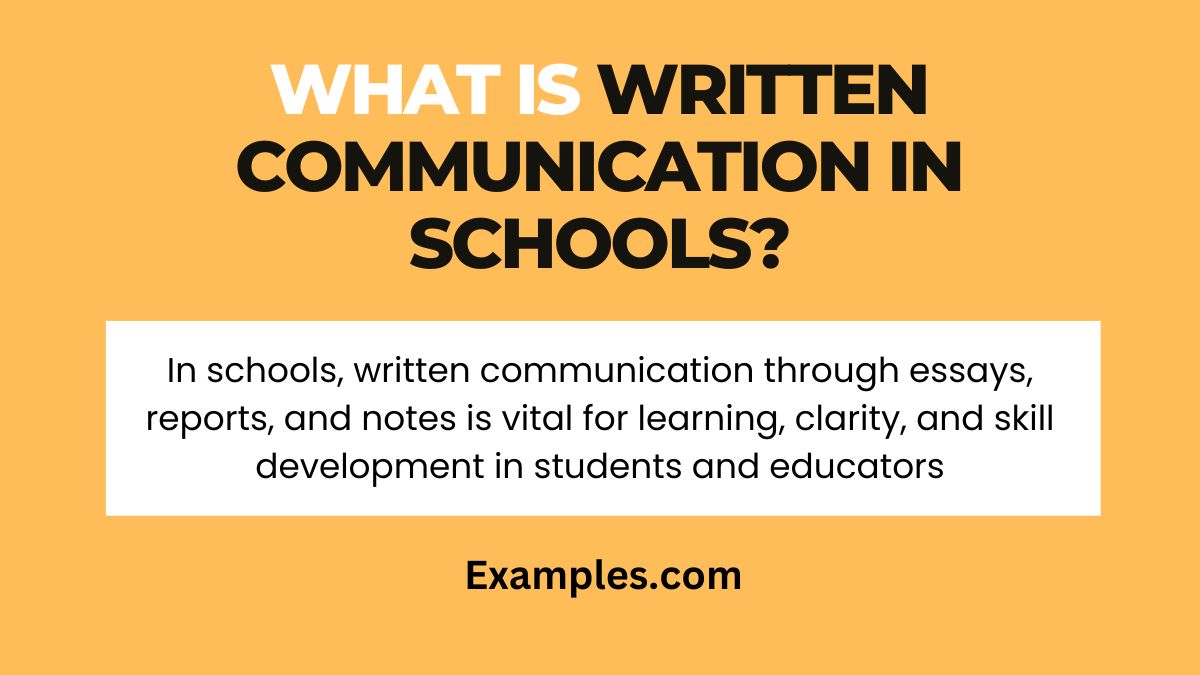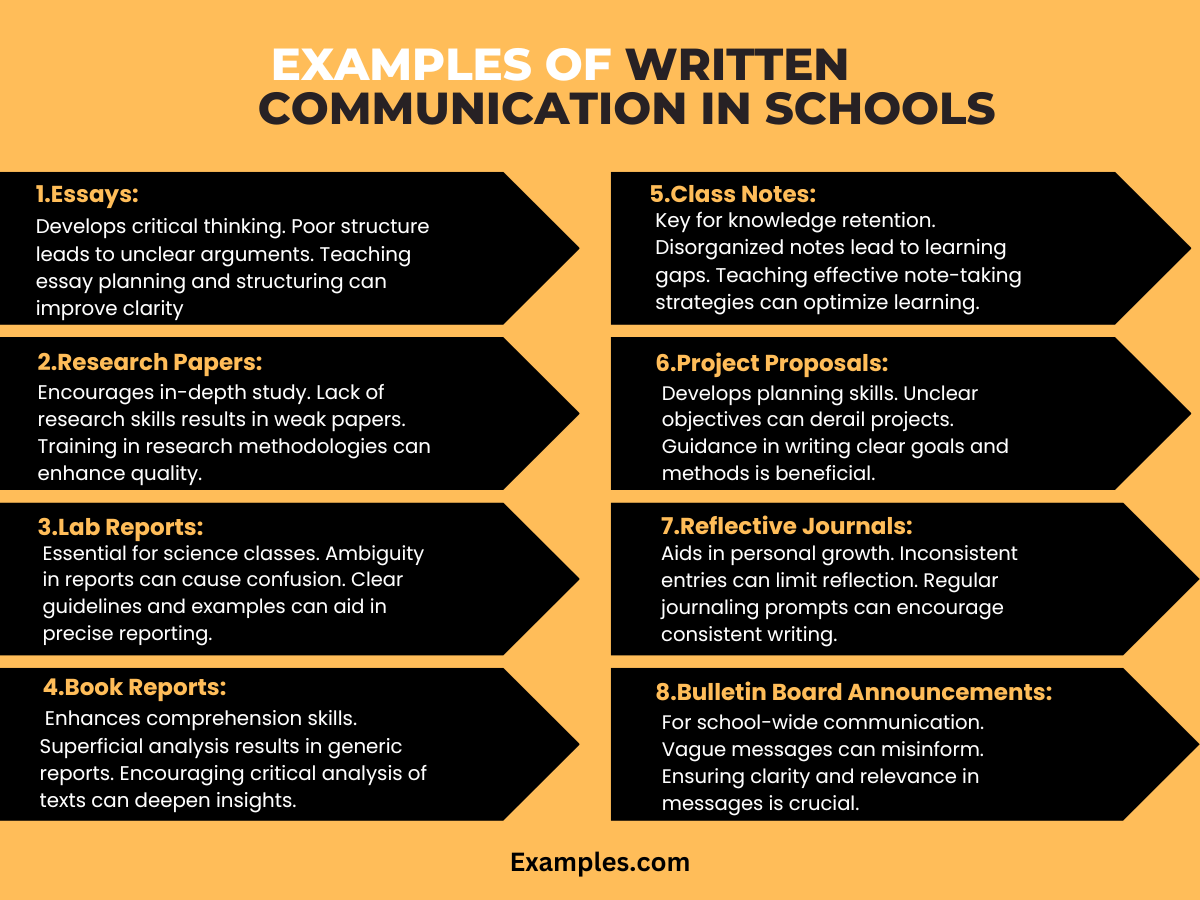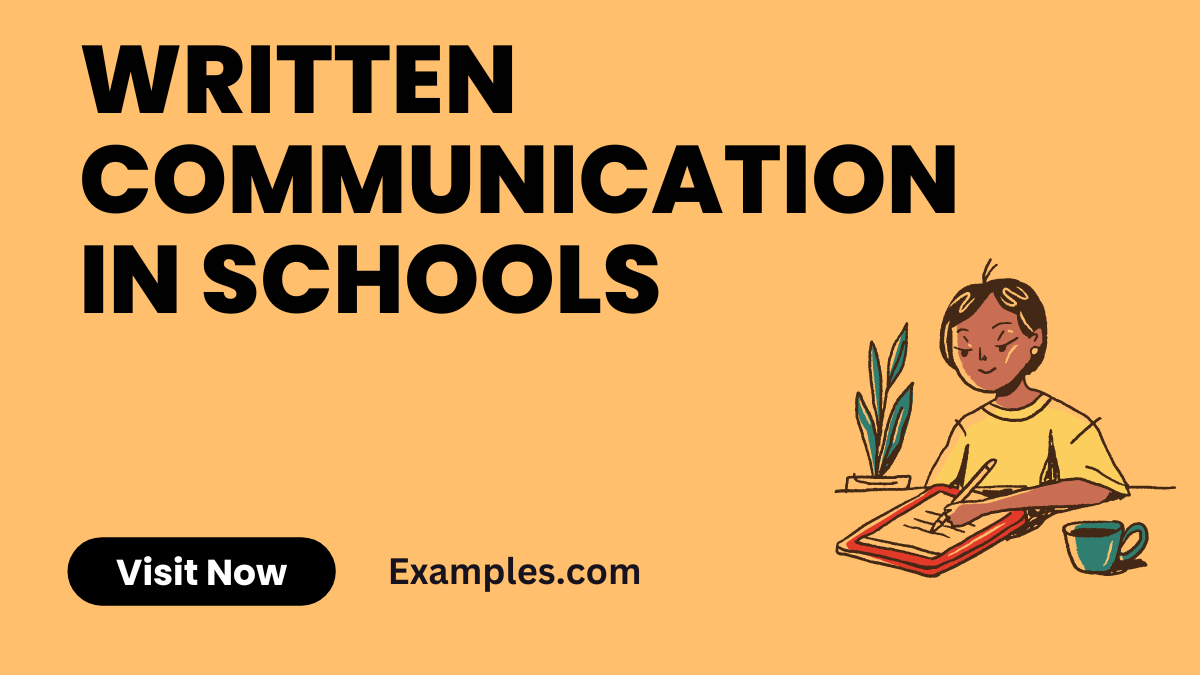9+ Written Communication in Schools Examples
Discover the essential role of Written Communication in Schools through this comprehensive guide. We delve into various communication examples from classroom notes to digital correspondence, highlighting how they shape educational experiences. This guide offers insights into the effects and solutions for common communication challenges in school settings. Explore real-world examples and practical advice to enhance the efficacy of written communication, a critical skill for academic success and future endeavors. Dive into this rich resource to transform the way students and educators interact and learn.
What is Written Communication in Schools? – Meaning

Written Communication in Schools refers to the use of written words to exchange information and ideas within an educational setting. This includes various forms of writing, such as essays, reports, assignments, and notes, used by students and educators. It’s a key part of learning and teaching, helping to clarify complex concepts, document learning progress, and develop students’ critical thinking and writing skills. This form of communication is fundamental in education, facilitating clear and permanent records of academic work.
10 Written Communication in Schools

Exploring Written Communication in Schools unveils its pivotal role in education. From essays to digital notes, effective written communication fosters learning, clarity, and engagement. Understanding its challenges and solutions is crucial for educational success. Here, we highlight ten distinct examples, each with its unique context, causes of issues, and strategies for improvement, emphasizing the transformative power of proficient writing skills in the academic arena.
- Essays: Develops critical thinking. Poor structure leads to unclear arguments. Teaching essay planning and structuring can improve clarity.
- Research Papers: Encourages in-depth study. Lack of research skills results in weak papers. Training in research methodologies can enhance quality.
- Lab Reports: Essential for science classes. Ambiguity in reports can cause confusion. Clear guidelines and examples can aid in precise reporting.
- Book Reports: Enhances comprehension skills. Superficial analysis results in generic reports. Encouraging critical analysis of texts can deepen insights.
- Class Notes: Key for knowledge retention. Disorganized notes lead to learning gaps. Teaching effective note-taking strategies can optimize learning.
- Emails to Teachers: Builds professional communication skills. Informal tone can be inappropriate. Educating about professional email etiquette can refine communication.
- Bulletin Board Announcements: For school-wide communication. Vague messages can misinform. Ensuring clarity and relevance in messages is crucial.
- Project Proposals: Develops planning skills. Unclear objectives can derail projects. Guidance in writing clear goals and methods is beneficial.
- Reflective Journals: Aids in personal growth. Inconsistent entries can limit reflection. Regular journaling prompts can encourage consistent writing.
- Online Discussion Posts: Enhances digital literacy. Misinterpretation can occur in online discussions. Teaching concise and respectful online communication can improve understanding.
Each example highlights the significance of written communication in various school settings, emphasizing the need for clarity, structure, and appropriate style to maximize its educational benefits.
What is Written Communication in Schools?
- Definition: Involves students and educators expressing and exchanging information through written forms like essays, assignments, and emails.
- Educational Tool: Helps students articulate their understanding, organize thoughts, and develop critical thinking skills.
- Teacher Communication: Vital for educators to create lesson plans, provide feedback, and communicate with students and parents.
- Digital Integration: With technology’s role in education growing, digital literacy and written communication have become increasingly intertwined.
Why is Written Communication Important in the Workplace?
- Diverse Applications: Includes emailing, report writing, and drafting business proposals.
- Clarity and Efficiency: Ensures information is clearly conveyed and tasks are properly understood and executed.
- Professionalism: Well-written documents reflect an organization’s credibility and competence.
- Global Communication: Essential in a globalized business environment for team members across different locations.
- Legal and Compliance: Plays a crucial role in legal documentation, requiring precision and clarity.
- Productivity and Collaboration: Acts as a key driver for productivity and collaboration in professional settings.
What are the Challenges in Written Communication?
In the context of Written Communication in Schools, several challenges can impede its effectiveness.
- Lack of Clarity: Students may struggle to express their thoughts clearly, leading to misunderstandings or incomplete communication.
- Inadequate Structure: Without a well-organized structure, written pieces can become confusing and fail to convey the intended message effectively.
- Grammar and Syntax Issues: Poor grammar and incorrect syntax can significantly diminish the quality of communication and make the text difficult to understand.
- Limited Vocabulary: A restricted range of vocabulary can hinder the ability to express complex ideas or emotions effectively.
- Technological Barriers: In digital communication, lack of access to or familiarity with technology can be a major obstacle.
- Cultural Differences: In diverse educational environments, cultural differences can affect writing styles and interpretation of written content.
- Time Constraints: Under tight deadlines, the quality of written communication can suffer, leading to rushed or incomplete information.
- Fear of Misinterpretation: Anxiety about how their writing will be interpreted can inhibit students from expressing themselves fully.
- Plagiarism Concerns: The ease of access to information online can lead to issues with originality and intellectual property.
- Audience Awareness: Difficulty in tailoring the communication style to suit different audiences (peers, teachers, parents) can affect effectiveness.
What is a Major Disadvantage of Written Communication?
A major disadvantage of written communication, particularly in educational settings, is the lack of immediate feedback. Unlike verbal communication where responses are instantaneous, written communication often involves a delay in receiving feedback. This can be problematic in several ways:
- Delayed Clarification: If the reader misinterprets the message, it might take time before the misunderstanding is clarified.
- Emotional Disconnect: Written communication lacks the emotional nuances of face-to-face or verbal exchanges, which can lead to a disconnect in understanding the writer’s true intent.
- Inflexibility: Once a written message is sent, especially in formal contexts like academic papers or emails, it cannot be easily amended or rephrased in real-time.
- Risk of Misinterpretation: Without verbal cues and tone of voice, written words can be easily misinterpreted, leading to communication errors.
- Overdependence on Writing Skills: The effectiveness of written communication heavily relies on the writer’s proficiency in writing, which may not accurately reflect their knowledge or competence in the subject matter.
This disadvantage highlights the importance of developing strong written communication skills and the need for complementary forms of communication in educational environments.
How is Communication Used in School?
In schools, communication is used for teaching, learning, giving feedback, and maintaining administrative coordination. It encompasses classroom discussions, written assignments, and digital interactions.
What are Written Communication Strategies?
Written communication strategies include clear structuring, using appropriate language and tone, proofreading for errors, and tailoring messages to the audience to enhance clarity and understanding.
When Not to Use Written Communication?
Avoid written communication when immediate feedback is needed, for conveying complex emotional messages, or in situations where verbal or face-to-face interaction is more effective and engaging.
Written Communication in Schools plays a crucial role in shaping educational experiences. Through various examples, we’ve seen its impact and addressed common challenges. Effective strategies and understanding when to utilize different forms of communication are key to enhancing understanding and engagement in educational settings. Mastering this skill is vital for academic success and future professional endeavors.



